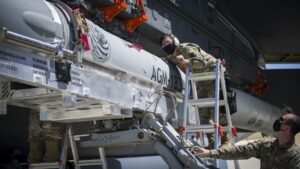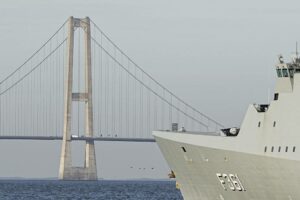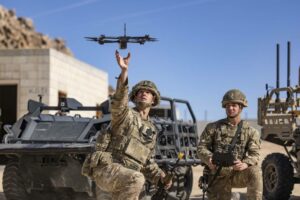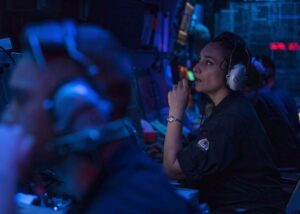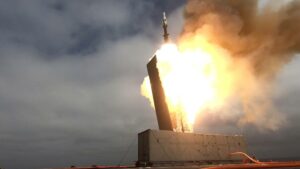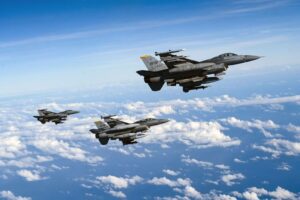WASHINGTON ― Marine leaders aim to put a Navy field corpsman at the squad level as part of ongoing reconfiguration and experiments with of the service’s infantry battalions.
Exact manning numbers and distribution are still in early stages, but staff with the Marine Corps Warfighting Labratory shared initial work on increasing medical assets to the infantry battalion during a panel discussion at the Modern Day Marine Expo in Washington.
“That’s a tough problem to solve and something we’re really just starting to incorporate into our experimentation,” said Col. Christopher Bronzi, director of the Marine Corps Warfighting Laboratory Experiment Division.
Beyond corpsmen, the Corps is looking for ways to add more medical officers and physician’s assistants and ensure more robust medical training for all members of the battalion for immediate care.
RELATED
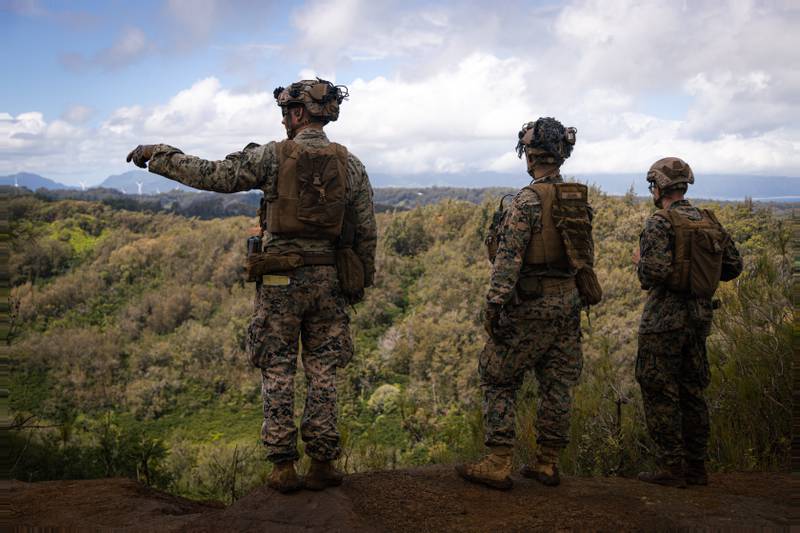
Bronzi and Capt. Mike Hogan, head of Marine Corps Warfighting Lab’s infantry battalion experiments, each cautioned that the lab is at its early stages of working through the increased medical assets needed. Phase I of the battalion experiments concluded recently with the announcement that 21 active-duty infantry battalions will transition to a manning of 811 Marines and 69 Navy support staff.
“We are hoping to move corpsmen down to the squad level,” Hogan said. “So that is moving a medical capability, someone who’s trained, purpose-built and professional at medical care forward, closer to the tactical edge.”
It’s not yet clear how many of those support staff would be medical, what billets would be created and what capabilities they will have. That’s a major focus of Phase II of the battalion experiments, set to kick off with 3rd Battalion, 4th Marine Regiment, out of Twentynine Palms, California, by January 2024.
The Phase II portion will last approximately 18 months, Brig. Gen. Kyle Ellison, Marine Corps Warfighting Lab commander, said during a June 2 call with reporters covering the Force Design 2030 annual update.
Force Design 2030 is the Corps’ yearslong effort to transition the service into more disparate, highly technically capable force to combat peer adversaries and ensure U.S. Navy access to currently access-denied areas such as spaces in the Pacific region to counter Chinese military efforts to control sea access in their nation’s areas of interest.
Historically in the Marine Corps, Navy corpsmen resided at the platoon level, and more senior corpsmen and medical assets stayed at the battalion level with headquarters and service companies and at higher-level units such as the regiment or in an attached, support capacity.
In war-gaming and exercises during Phase I experimentation it was difficult to get the medical personnel and technology needed to the tactical edge where Marines needed them most, the captain said.
He emphasized that the problem didn’t reside only with the infantry battalion experiments. Separate areas of focus such as littoral mobility, contested logistics and work on the Corps’ newest formation, the Marine littoral Regiment, also will contribute as the work continues.
The increased medical move also has roots in long-standing concerns about how great power competition combat with peer rivals could deny access to medical care and casualty evacuation that most of the military grew accustomed to in the past decades of fighting counterinsurgency and counterterrorism wars.
That’s because peer and near-peer adversaries have invested in air defense, strike capabilities and other ways to contest U.S. military airpower dominance that has reigned mostly unchallenged since the Persian Gulf War.
Marine Corps Times and other defense media have reported for years about warnings that the “golden hour” of immediate, high-level medical interventions for casualties isn’t guaranteed.
Various research initiatives are seeking ways to pipe in video and audio communication from stateside military doctors to advise medics with advanced training, such as in U.S. Special Operations Command, so that a skilled medic or corpsman could even conduct more complex field expedient surgeries if the patient couldn’t be evacuated from an austere location.
In another example, the Army has conducted multiyear review of autonomous drones capable of carrying a soldier off the battlefield for medical care.
Todd South has written about crime, courts, government and the military for multiple publications since 2004 and was named a 2014 Pulitzer finalist for a co-written project on witness intimidation. Todd is a Marine veteran of the Iraq War.
- SEO Powered Content & PR Distribution. Get Amplified Today.
- PlatoData.Network Vertical Generative Ai. Empower Yourself. Access Here.
- PlatoAiStream. Web3 Intelligence. Knowledge Amplified. Access Here.
- PlatoESG. Automotive / EVs, Carbon, CleanTech, Energy, Environment, Solar, Waste Management. Access Here.
- BlockOffsets. Modernizing Environmental Offset Ownership. Access Here.
- Source: https://www.defensenews.com/news/your-marine-corps/2023/06/28/a-corpsman-in-the-squad-marine-planners-seek-better-combat-care/
- :has
- :is
- :not
- :where
- 1
- 10
- 2014
- 2024
- 2030
- 4th
- 70
- a
- About
- access
- add
- advanced
- advise
- aim
- AIR
- All
- also
- an
- and
- Announcement
- annual
- Another
- approximately
- ARE
- areas
- Army
- AS
- Assets
- assistants
- At
- audio
- autonomous
- autonomous drones
- Battlefield
- BE
- because
- Better
- but
- by
- california
- call
- capabilities
- capability
- capable
- Capacity
- care
- carrying
- chinese
- Christopher
- clear
- closer
- combat
- Communication
- Companies
- competition
- complex
- Concerns
- concluded
- Conduct
- conducted
- contest
- continues
- contribute
- control
- could
- Counter
- Courts
- covering
- created
- Crime
- Currently
- day
- decades
- Defense
- Design
- difficult
- Director
- discussion
- disparate
- Division
- Doctors
- Dominance
- down
- Drones
- during
- each
- Early
- Edge
- effort
- efforts
- Ellison
- emphasized
- ensure
- Even
- example
- experiment
- experiments
- Expo
- false
- field
- fighting
- Focus
- For
- Force
- formation
- Forward
- from
- Gen
- get
- Government
- great
- great power
- guaranteed
- Have
- head
- Headquarters
- high-level
- highly
- hoping
- How
- http
- HTTPS
- i
- if
- ii
- image
- images
- immediate
- in
- incorporate
- increased
- increasing
- initial
- initiatives
- interest
- into
- invested
- iraq
- IT
- ITS
- January
- jpg
- june
- just
- kick
- lab
- laboratory
- Last
- leaders
- Level
- location
- logistics
- long-standing
- looking
- major
- many
- Marine
- Media
- medical
- medical care
- Members
- mike
- Military
- mobility
- Modern
- months
- more
- most
- mostly
- move
- moving
- multiple
- multiyear
- Named
- Nations
- needed
- Newest
- numbers
- of
- off
- officers
- on
- ongoing
- only
- Operations
- or
- Other
- our
- out
- Pacific
- panel
- panel discussion
- part
- past
- patient
- peer
- Personnel
- phase
- pipe
- plato
- Plato Data Intelligence
- PlatoData
- power
- Problem
- professional
- project
- publications
- put
- really
- recently
- region
- Reported
- research
- review
- rivals
- robust
- roots
- s
- Said
- Screen
- SEA
- seeking
- senior
- separate
- service
- set
- shared
- since
- skilled
- So
- SOLVE
- Someone
- something
- South
- spaces
- special
- Staff
- stages
- Starting
- stayed
- Still
- strike
- such
- support
- tactical
- technically
- Technology
- that
- The
- their
- Them
- they
- those
- Through
- times
- to
- tough
- trained
- Training
- transition
- u.s.
- U.S. Navy
- units
- Update
- veteran
- Video
- war
- was
- washington
- ways
- What
- will
- with
- witness
- Work
- working
- would
- written
- years
- yet
- zephyrnet



